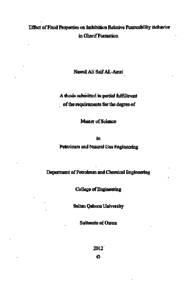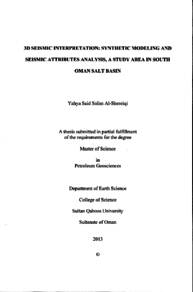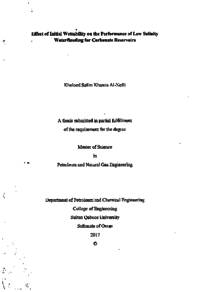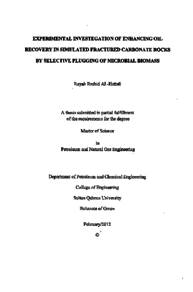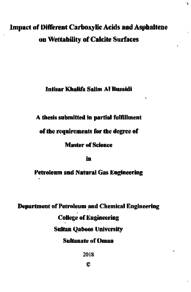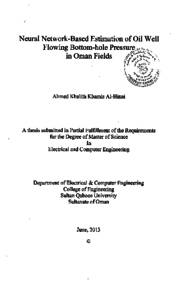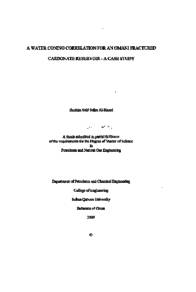Document
Effect of fluid properties on imbibition relative permeability behavior in Gharif formation
Gregorian
2012
Language
English
English abstract
Relative permeability is a principal property that controls the simultaneous flow of fluids in porous media. It helps in making engineering estimates of productivity and ultimate recovery from reservoirs. Obtaining experimental relative permeability is expensive and time consuming. As such, models for relative permeability are developed. Relative permeability behavior is controlled by several factors including pore geometry, saturation, wettability and fluid viscosity. Wettability is a major controlling factor of fluid location, flow and distributions within reservoirs. Different fields have different conditions that influence the relative permeability, hence different relative permeability models are proposed. In this study, a comprehensive investigation aiming to explore similarities and differences in oil properties within Gharif formation with objective of understanding the effect of oil properties on experimental relative permeability behavior. To do this, 98 relative permeability and capillary pressure data sets were considered. Checked and qualified relative permeability data were corrected for capillary end effects using capillary pressure data using MoRes simulator. Then principal component analysis was used to map out similarities and differences in crude oils from different fields. C6+ was found to be a controlling factor of data variance. Three distinct groups for Gharif fields (light, intermediate and mixture of light and heavy) were identified. However, due to insufficient experimental data (oil composition and relative permeability) and lack of other data (PVT and wettability), no conclusive observations were possible from studying relative permeability behavior as a function of oil properties. As a final step, the 22 relative permeability data sets from numerical simulation were used to generate a reference model for Gharif formation.
Description
Thesis
Member of
Resource URL
Arabic abstract
تعتبر النفاذية النسبية من اهم الخصائصن التي تتحكم في سريان الموائع في الوسط المسامي. فهي تساعد في معرفة التقديرات الهندسية للإنتاج والناتج النهائي للمكامن البترولية. إن الحصول على قياسات النفاذية النسبية مكلف ويستهلك زمنا ولهذا السبب تم تطوير نماذج يعتمد عليها في حساب النفاذية النسبية للمكامن. توجد العديد من العوامل التي تؤثر على النفاذية النسبية من أهمها ابطال مسامات الصخر والتشبع، وقابلية الصخر للترطيب بإحدى الموائع (wettability) ولزوجة الموائع. تعتبر رطوبة الصخر العامل الرئيسي الذي يسيطر على موقع المائع وسيلانه وتوزيعه اخل المكامن النفطية. وحيث أن لكل مكمن نفطي عوامل مختلفة تؤثر على النفاذية النسبية، فلهذا تم استحداث نماذج مختلفة للنفاذية النسبية لتتناسب مع طبيعة المكمن في هذه الدراسة تم إجراء بحث شامل يهدف الى دراسة أوجه التشابه والإختلاف في خصائص النفط في مكمن "غريف" مع معرفة تأثير خصائص النفط على النفاذية النسبية. لقد تم جمع 98 عينة للنفاذية النسبية والضغط الشعري وانتقائها وتصحيحها بواسطة بيانات الضغط الشعري بإستخدام المحاكاة الرقمية. وقد وجد من خلال تحليل النتائج أن الجزء الثقيل من النفط الخام هو العامل الرئيسي للتباين في البيانات وان هناك ثلاث مجموعات الحقول النفط الخام في مكمن غريف ( نفط خفيف ومتوسط و خليط من الخفيف والثقيل ).ونظرا لعدم توفر البينات الكافية لنفاذية النسبية والبينات المتعلقة برطوبة الصخر وبمكونات النفط الخام لمعظم الحقول في مكمن"غريف" فإنه كان من الصعب الخروج بملاحظات مؤكدة حول تأثير خصائص النفط الخام على النفاذية النسبية. وكمرحلة أخيرة في هذه الدراسة تم استخدام جميع بينات النفاذية النسيبة الناتجة من المحاكاة الرقمية في بناء نموذج مرجعي للنفاذية النسبية لمكمن " غريف "
Category
Theses and Dissertations

